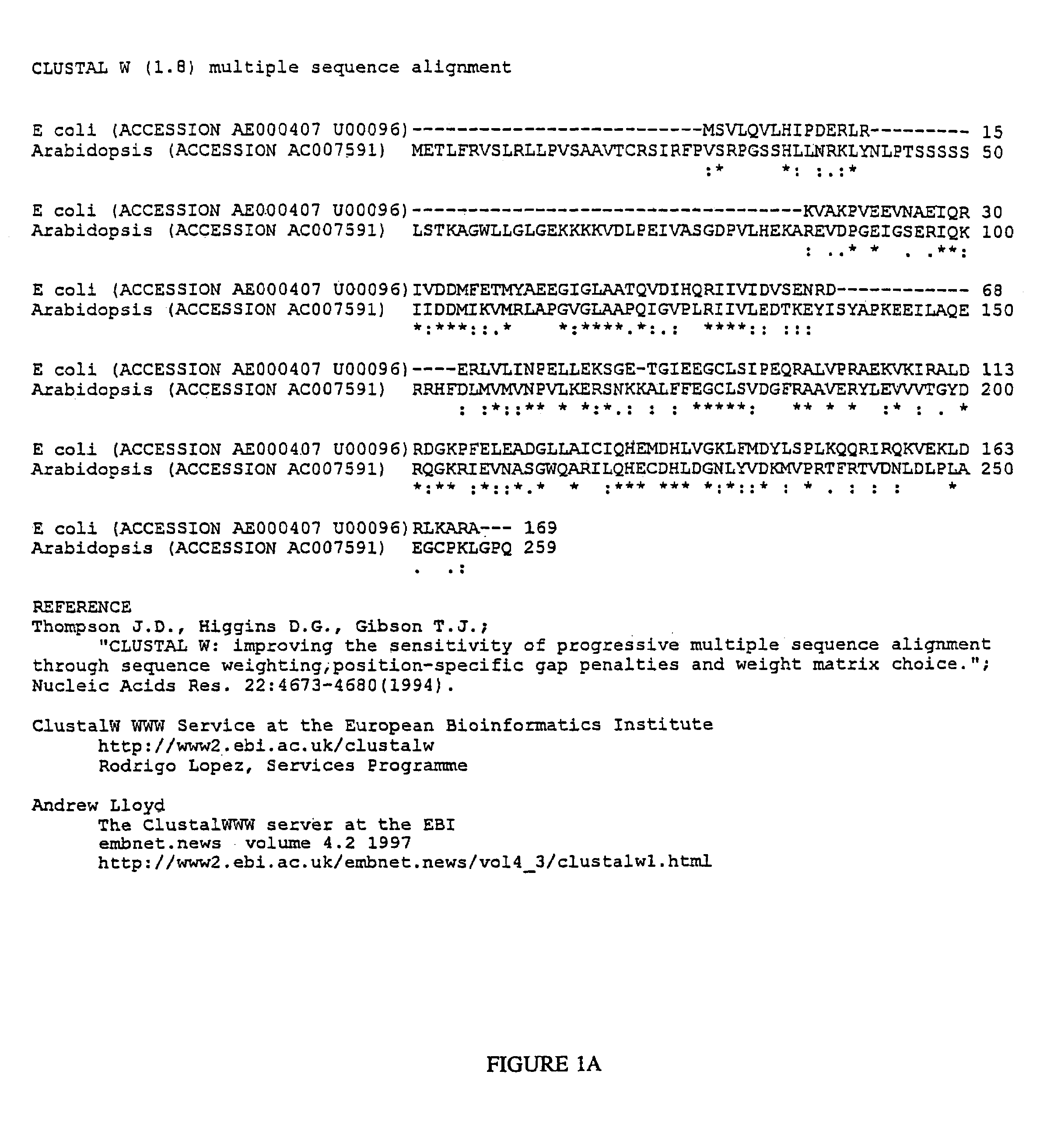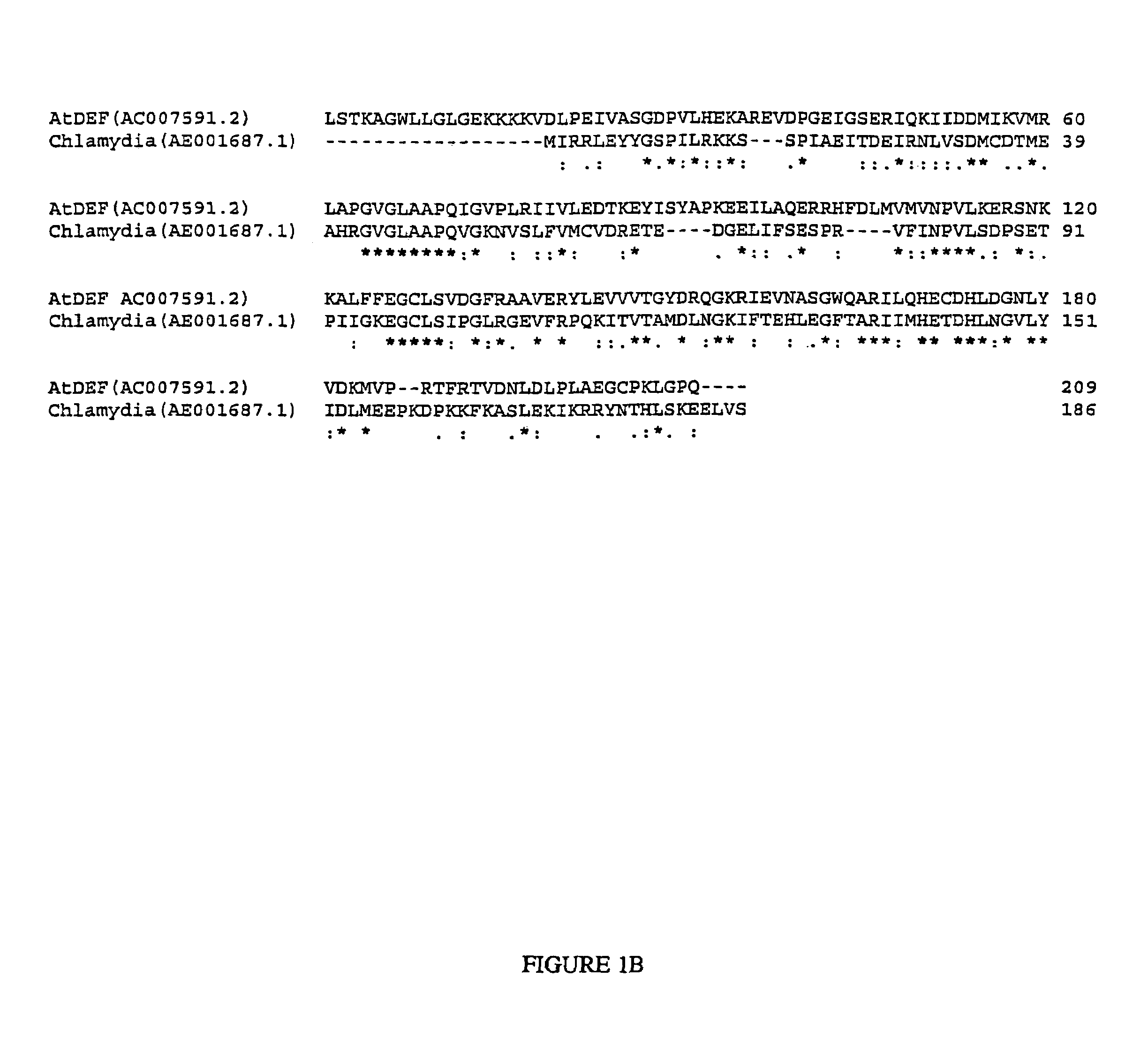Inhibitors of plant peptide deformylase for use as broad-spectrum herbicides and methods for identifying the same
a technology of plant peptide deformylase and broad-spectrum herbicides, which is applied in the field of herbicide identification methods, can solve the problem that most mature proteins do not retain the n-formyl group
- Summary
- Abstract
- Description
- Claims
- Application Information
AI Technical Summary
Benefits of technology
Problems solved by technology
Method used
Image
Examples
example 1
Identification and Isolation of an ArabidopsisPeptide Deformylase Gene (Atdef1)
[0138]The Arabidopsis thaliana genome sequencing project recently annotated a gene (AC007591; F9L1.35 @ http:www.ncbi.nlm.nih.gov;) as a putative peptide deformylase based on substantial homology to Chlamydia pneumoniae (AE001687) protein. An identifiable chloroplast targeting sequence was also identified. The predicted protein sequence was analyzed using the ChloroP program (Emanuelsson et al., Protein Science 8:978-984 (1999)), which revealed a putative transit peptide of 50 amino acids. (See FIGS. 1A and 1B.)
Construction of a Peptide Deformylase Clone (Atdef1)
[0139]Experiments were initiated to amplify Arabidopsis thaliana peptide deformylase complementary DNA (cDNA) using Reverse Transcriptase-Polymerase Chain Reaction (RT-PCR).
Isolation of Arabidopsis thaliana RNA
[0140]Total RNA was isolated using TRIzol™ reagent from GIBCO BRL, following the manufacturer's protocol. Briefly, the procedure was as fol...
example 2
Expression and Purification of Arabidopsis thaliana Peptide Deformylase (AtDEF1)
Cloning into pLEX
Restriction Endonuclease Digestion
[0149]The peptide deformylase gene (from Example I) was digested with NdeI and XhoI and ligated into pLEX (Invitrogen) that had been digested with NdeI and XhoI restriction endonucleases according to the manufacturer's protocol (PL Expression system version D 180129).
Ligation to pLEX
[0150]The 10 μl ligation reaction contained 1 μl of linearized pLEX vector (50-200 ng), 2 μl of linearized insert (5-200 ng), 1 μl of 10× ligation Buffer (should have ATP), sterile water to 9 μl, and 1 μl of T4 DNA Ligase (0.5 Weiss Units). The reaction mixture was incubated for 12-16 hours at 15° C.
Transformation
[0151]Three to five microliters of the ligation reaction were added to a separate tube of competent cells (GI724) and mixed gently with a pipette tip (without PIPETTING UP AND DOWN). The tubes were incubated on ice for 30 minutes. All tubes were then transferred to 4...
example 3
In Vitro Chloroplast Import of Peptide Deformylase
[0163]Although signal peptides vary in amino acid sequence and length, the tendencies for certain classes of amino acids as well as semi-conserved cleavage sites have facilitated computer modeling and prediction of signal sequences within a putative nuclear-encoded chloroplast protein. A neural network based predictor has recently been developed that discriminates transit peptide sequences from non-transit peptide sequences with high sensitivity and specificity. (Emanuelsson et al., Protein Science 8:978-984 (1999)).
[0164]The Arabidpsis thaliana peptide deformylase predicted protein sequence was analyzed using the neural network based predictor (Emanuelsson et al. Protein Science (1999) 8:978-984) ChloroP program, which predicted a signal peptide of 50 amino acids with a cleavage site between amino acids 50 and 51. Since signal peptides are capable of mediating precise chloroplast targeting and import, in vitro chloroplast import exp...
PUM
| Property | Measurement | Unit |
|---|---|---|
| temperatures | aaaaa | aaaaa |
| temperatures | aaaaa | aaaaa |
| temperatures | aaaaa | aaaaa |
Abstract
Description
Claims
Application Information
 Login to View More
Login to View More - R&D
- Intellectual Property
- Life Sciences
- Materials
- Tech Scout
- Unparalleled Data Quality
- Higher Quality Content
- 60% Fewer Hallucinations
Browse by: Latest US Patents, China's latest patents, Technical Efficacy Thesaurus, Application Domain, Technology Topic, Popular Technical Reports.
© 2025 PatSnap. All rights reserved.Legal|Privacy policy|Modern Slavery Act Transparency Statement|Sitemap|About US| Contact US: help@patsnap.com



